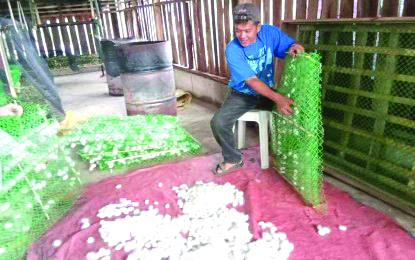
ILOILO City – As response to the increasing demand for silk in the country, farmers from the province’s Lambunao town took to mulberry and silk cocoon production.
Champion Farmers Program (CFP) executive director Ariel Lastica of the said town said they are supported by the Philippine Fiber Industry Development Authority (PhilFIDA) and the Organization for Industrial, Spiritual, Cultural Advancement (OISCA), a Japanese nongovernment organization.
Lastica said OISCA director Shimege Watanabe lobbied back in Japan that Lambunao town is included in the project after seeing the interest of the CFP.
In June 2019, a memorandum of agreement was signed between the local government of Lambunao, PhilFIDA, OISCA and the CFP for the establishment of mulberry production sites for the rearing of silkworms and production of silk (sericulture).
“It is the only project in the Visayas that was included in the silk production project of OISCA,” he said.
The mulberry production site started in 2019 in barangays Cayan Oeste, Daanbanwa, Legayada, San Gregorio and Panuran.
Some 14,000 cuttings were made available by the PhilFIDA and OISCA. The group also provided portions of the materials for the establishment of a rearing house for the silkworm.
In January this year, the five pilot farmers had hands-on training on silk cocoon production.
They started with just one-fourth box of silkworms and after 25 days, on Feb. 17, 2020, they harvested seven kilograms of Class A cocoon, he added.
The silk cocoons will be processed in Bago City where an OISCA Filature Plant is based.
Meanwhile, PhilFIDA OIC regional director for Western Visayas Evelyn Cagasan said the area identified by Lambunao is suitable for mulberry plants.
She added that if the mulberry leaves that will be fed to the silkworms are of good quality, then they will also produce good quality cocoon.
She said the silk is combined with abaca, cotton, and piña to make the cloth shiny.
The annual cocoon production of the region is 3,106.86 kilograms while the silk yarn is 88.76 kilograms. The annual demand of the weaving sector is 150 kilograms of yarn. Cocoons can be classified as A, B, and C or even AA depending on size and shapes.
She added that about 1.2 to 1.5 kilometers of silk can be extracted from one cocoon regardless of size. Silk that is extracted from eight cocoons can produce one yarn.
She added that while the moriculture (cultivation of mulberry plants) and sericulture industry is “still at its infancy stage” in Western Visayas, the industry is almost complete because there are eggs that are produced as OISCA has a silkworm egg production.
There is also a facility that produces textile and pure silk cloth.
He added that for every rearing house that can grow two boxes of silkworm, a family can earn P20,000 in just three months, or can jump P80,000 a year.
Antonio Castronuevo, technical assistance head of the PhilFIDA in Western Visayas, said mulberry trees thrive in areas with temperature ranging from 28 to 32 degrees.
It is best planted during the onset of the rainy season and will be ready for feeding after eight months.
The 4,300 cutting of mulberry can be planted in one-third of a hectare plantation and can supply three to four persons. Each person can have one box of silkworm eggs, equivalent to 20,000 silkworms.
The rearing house for the silkworm has a measurement of five meters by 12 meters and must be protected from rats, birds, and other pests.
Lastica said they intend to mix the silkworms after they are removed from the cocoon into their vermi-facility so they can decompose thoroughly.(with a report from PNA/PN)







